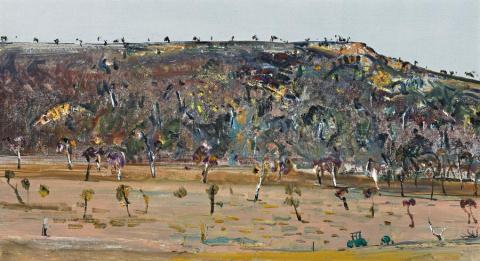HILLSIDE LANDSCAPE WITH GREEN TRACTOR, 1978
FRED WILLIAMS
oil on canvas
51.0 x 91.5 cm
Estate of the Artist (number LW712, inscribed verso)
Adam Galleries, Melbourne
Private collection, Melbourne
The Millennium Collection, Adam Galleries, Melbourne, 17 November – 8 December 1999
Fred Williams, in his You Yangs series of oil paintings of 1963-64, chose as his principal motif views of the flat landscape seen from, not of the ranges themselves. Distinguished by the absence of a horizon, with touches and textures of paint worked across a field of colour, he created a highly individual pictorial space. A splendid and typical example is You Yangs II 1963 in the collection of the National Gallery of Australia, Canberra.
As Patrick McCaughey has commented, these paintings became to be regarded as the quintessential Williams, defining his art in the public mind.1 The You Yangs, however, offer a richly varied choice of pictorial possibilities, especially of the noble profile of the ridges themselves, as can be seen in our painting. As a series of granite ridges, they rise dramatically above the Werribee Plain to dominate the landscape southwest of Melbourne. Their name is derived from the Aboriginal 'Wurdi Youang' or 'Ude Youang' appropriately meaning 'big mountain in the middle of a plain'. Hillside Landscape with Green Tractor, You Yangs is a witness to their on going appeal to Williams. Although painted in 1978 long after the original series, it was not unusual for Williams to return to a favoured motif, working it into new ideas.
Williams employed many different viewpoints for his landscapes, with endless variations on the aerial view and that seen from the ground as local features are presented in the more traditional pictorial manner. While Hillside Landscape with Green Tractor, You Yangs adopts the latter approach, it also has the fascinating addition of the green machine. Highlighted by its contrasting colour and prominent foreground position, it marks the presence of man within the landscape. Although of incidental interest to the whole picture, it may refer to the insignificance of man within the landscape, represented by a machine and not himself. Motifs of this kind occur occasionally throughout Williams's oeuvre. In 1968 at One Tree Hill in the Dandenongs he included a fugitive in one and his painting companion Hal Hattam in another. In Lilydale Landscape with Blue Train 1974 the long locomotive is firmly embedded in the painting's structure. James Mollison observed that 'Although [Williams] had often tried to paint landscape and buildings in the past, pylons, roads, trains and buildings now [1974] became regular features, functioning as part of the narrative in much the same way as the rocks and trees of earlier paintings.'2 As our painting shows, Williams could move with consummate ease between the more abstract landscapes and those of greater realism, suggestions of human presence deepening the picture's purpose.
1. McCaughey, P., Fred Williams, Bay Books, Sydney, 1980, p. 153
2. Mollison, J., A Singular Vision: The Art of Fred Williams, Australian National Gallery, Canberra, 1989, p. 185
DAVID THOMAS
